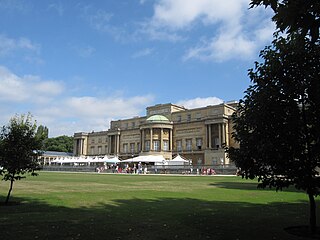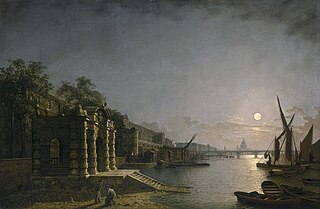
Buckingham Palace is a royal residence in London, and the administrative headquarters of the monarch of the United Kingdom. Located in the City of Westminster, the palace is often at the centre of state occasions and royal hospitality. It has been a focal point for the British people at times of national rejoicing and mourning.

Henry Bennet, 1st Earl of Arlington, KG, PC was an English statesman.

St James's Palace is the most senior royal palace in London, the capital of the United Kingdom. The palace gives its name to the Court of St James's, which is the monarch's royal court, and is located in the City of Westminster in London. Although no longer the principal residence of the monarch, it is the ceremonial meeting place of the Accession Council, the office of the Marshal of the Diplomatic Corps, and the London residence of several members of the royal family.

Buckingham Palace Garden is a large private park attached to the London residence of the British monarch. It is situated to the rear (west) of Buckingham Palace, occupying a 17-hectare (42-acre) site in the City of Westminster and forms the largest private garden in London. It is bounded by Constitution Hill to the north, Hyde Park Corner to the west, Grosvenor Place to the south-west, and the Royal Mews, King's Gallery, and Buckingham Palace itself to the south and east.

Jean-Henri Riesener was a famous German ébéniste (cabinetmaker), working in Paris, whose work exemplified the early neoclassical "Louis XVI style".

Piano nobile is the architectural term for the principal floor of a palazzo. This floor contains the main reception and bedrooms of the house.

The King's Gallery, previously known as the Queen's Gallery, is a public art gallery at Buckingham Palace, the official residence of the British monarch, in London. First opened to the public in the reign of Elizabeth II in 1962, it exhibits works of art from the Royal Collection on a rotating basis. Enlarged in the early 21st century, the gallery has its own separate public access entrance built in a 'new' classical style and typically displays about 450 works, mainly paintings and drawings.

The King's Gallery, previously known as the Queen's Gallery. is an art gallery in Edinburgh, Scotland. It forms part of the Palace of Holyroodhouse complex. It was opened in 2002 by Queen Elizabeth II, and exhibits works from the Royal Collection.

The Waterloo Vase is a 15-foot (4.6 m) stone urn, situated in the garden of Buckingham Palace in central London. Fashioned from a single piece of Carrara marble, it was initially presented to Napoleon I, who intended to have it carved in celebration of anticipated future military victories. After the Emperor’s defeat at the Battle of Waterloo, the uncarved vase was given to the Prince Regent, later George IV. The Prince commissioned the sculptor, Richard Westmacott to decorate the vase with reliefs celebrating the victory at Waterloo. The original plan to place the vase in the Waterloo Gallery at Windsor Castle proved unrealisable, the weight of the vase being greater than the gallery’s floors could bear. It was therefore given to the National Gallery in Trafalgar Square. Considering the vase surplus to its requirements, the gallery placed it first in Hyde Park, London and then into storage at the Victoria and Albert Museum. In 1903, it was offered by the museum to the new king, Edward VII, who installed it as a garden ornament in the grounds of Buckingham Palace, where it remains. The vase is a Grade I listed structure.
The office of Surveyor of the King's/Queen's Works of Art in the Royal Collection Department of the Royal Household of the Sovereign of the United Kingdom is responsible for the care and maintenance of the royal collection of works of art owned by the Sovereign in an official capacity, about 700,000 objects - many of museum quality. The collection is spread across the various official and historic residences. Those objects in the official residences are in constant use. Objects in the Royal Collection are distinct from those objects owned privately and displayed at Sandringham House and Balmoral Castle and elsewhere. The Surveyor oversaw conservation of works of art: there are three conservation workshops, including a recently constructed workshop in the Home Park, Windsor.
Sir Geoffrey de Bellaigue was Surveyor of the Queen's Works of Art from 1972 to 1996. His was the first full-time appointment to the office, and he did much to professionalise the Royal Collection department after being made the Director of the Royal Collection in 1988.
The Director of the Royal Collection is head of the Royal Collection Department, a department of the Royal Household of the Sovereign of the United Kingdom. The department is responsible for the day-to-day management and upkeep of the art collection of the British Royal Family; held in trust for the nation and successive monarchs, it is one of the largest and most important art collections in the world. It contains over 7,000 paintings, 40,000 watercolours and drawings, about 150,000 old master prints, as well as historical photographs, tapestries, furniture, ceramics, books, and the Crown Jewels of the United Kingdom. The Director of the Royal Collection is also an ex-officio trustee of Historic Royal Palaces.

York House was one of a series of grand mansions that formerly stood on the Strand, the principal route from the City of London to the Palace of Westminster.

The Royal Collection of the British royal family is the largest private art collection in the world.
Events from the year 1761 in Great Britain.

The finances of the British royal family come from a number of sources. The British government supports the monarch and some of his family financially by means of the Sovereign Grant, which is intended to meet the costs of the sovereign's official expenditures. This includes the costs of the upkeep of the various royal residences, staffing, travel and state visits, public engagements, and official entertainment. Other sources of income include revenues from the Duchies of Lancaster and Cornwall, income from assets of other trusts, income from private investments, and a parliamentary annuity.

Carl Vandyk was a successful London photographer born in Bunde, Germany. From 1882 he owned a studio at Gloucester Road taking images of the British Royal Family including Queen Victoria, King George V as well as other notables such as Alexander I of Yugoslavia, Christian X of Denmark, Buffalo Bill and Enrico Caruso. From 1901 the studio moved to Buckingham Palace Road, London.

Eia or Eye was an early medieval manor in Westminster, Middlesex and is now a part of Central London. It was about one mile west of the Palace of Westminster/Whitehall, about 2 miles west-south-west of the walled City of London, and about half a mile north of the River Thames.

Her Majesty Queen Elizabeth II – An 80th Birthday Portrait is a 2005 oil painting of Queen Elizabeth II by Rolf Harris, commissioned by the BBC for the Queen's 80th birthday. It was unveiled at the Queen's Gallery in Buckingham Palace and publicly displayed there from 2005 to 2006. A BBC television special about its creation, The Queen, by Rolf, was broadcast on BBC One on 1 January 2006. The painting was voted the second-most-favoured portrait of the Queen by the British public, but it was critically derided.

The Yellow Drawing Room is a room in Buckingham Palace. It is noted for its Chinoiserie decorative scheme and has been the setting for many portraits of members of the British royal family.
















